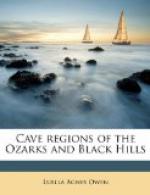When the percolating acidulated water passes slowly through a pure limestone it is filtered of impurities and deposits a crystal, either pure white or transparent; if it comes in contact with metallic bodies of any kind, it carries away more or less in solution to act as coloring matter; the beautiful pale green onyx in several Missouri counties taking its tint from the copper; in South Dakota, manganese in various combinations produces black and many shades of brown; in both states an excessive flow of water often carries a quantity of red or yellow clay which temporarily destroys the beauty of exposed surfaces, but in after years becomes a fine band of brilliant color.
Small wind caves are numerous in the Ozarks and being cold are frequently utilized for the preservation of domestic supplies. The entrance to one in the neighborhood of Marble Cave is high up on the hill-side south of Mr. Powell’s house and being visible from the porch was too tempting to be ignored, and the walk up to it for a better view was rewarded with a most charming bit of scenery as well. All the quiet valley, divided by a rushing little stream, lay before us in the shadow of early evening, while to the north and east the hills were brilliant in summer sunshine, with one small open glade gleaming vividly among the darker shades of forest green.
The cave was a very small room at the bottom of a steep, rocky, sloping passage, and contained no standing water, although there had been a heavy rainfall the night before and the opening is so situated as to especially favor the inflow, which naturally indicates a greater cave beneath a hidden passage. Here, as in most of the caves of the region, is found a small lizard: it is totally blind but its ancestors evidently were not, as is shown by conspicuous protuberances where the eyes should be, but over which the skin is drawn without a wrinkle or seam to indicate a former opening. These harmless creatures are not scaly, but are clothed in a soft, shining, well-fitted skin, and the largest seen were little more than six inches long.
Those who love perfect Nature in a most smiling mood should hasten to visit Marble Cave while yet no railroad quite touches the county.
FOOTNOTES:
[2] The naturalist referred to is the late Prof. E.D. Cope.
CHAPTER IV.
Fairy cave and Powell cave.
Fairy Cave enjoys the reputation of being the most beautiful yet discovered in that cavernous region, and consequently a visit to it was contemplated with considerable eagerness, although the mode of entrance had been described with sufficient accuracy to prevent any misconception of the difficulties to be overcome or the personal risk involved. To go from our temporary abiding place it was necessary to pass Marble Cave, and when we had gone that far Mr. Powell left




